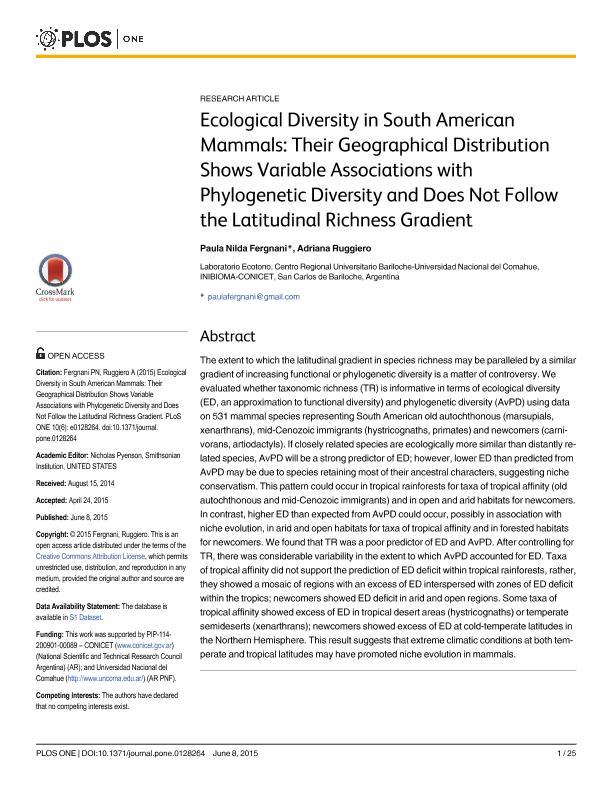Mostrar el registro sencillo del ítem
dc.contributor.author
Fergnani, Paula Nilda

dc.contributor.author
Ruggiero, Adriana

dc.date.available
2017-01-26T20:54:13Z
dc.date.issued
2015-06
dc.identifier.citation
Fergnani, Paula Nilda; Ruggiero, Adriana; Ecological Diversity in South American Mammals: Their Geographical Distribution Shows Variable Associations with Phylogenetic Diversity and Does Not Follow the Latitudinal Richness Gradient; Public Library Of Science; Plos One; 10; 6; 6-2015; 1-25
dc.identifier.issn
1932-6203
dc.identifier.uri
http://hdl.handle.net/11336/12047
dc.description.abstract
The extent to which the latitudinal gradient in species richness may be paralleled by a similar gradient of increasing functional or phylogenetic diversity is a matter of controversy. We evaluated whether taxonomic richness (TR) is informative in terms of ecological diversity (ED, an approximation to functional diversity) and phylogenetic diversity (AvPD) using data on 531 mammal species representing South American old autochthonous (marsupials, xenarthrans), mid-Cenozoic immigrants (hystricognaths, primates) and newcomers (carnivorans, artiodactyls). If closely related species are ecologically more similar than distantly related species, AvPD will be a strong predictor of ED; however, lower ED than predicted from AvPD may be due to species retaining most of their ancestral characters, suggesting niche conservatism. This pattern could occur in tropical rainforests for taxa of tropical affinity (old autochthonous and mid-Cenozoic immigrants) and in open and arid habitats for newcomers. In contrast, higher ED than expected from AvPD could occur, possibly in association with niche evolution, in arid and open habitats for taxa of tropical affinity and in forested habitats for newcomers. We found that TR was a poor predictor of ED and AvPD. After controlling for TR, there was considerable variability in the extent to which AvPD accounted for ED. Taxa of tropical affinity did not support the prediction of ED deficit within tropical rainforests, rather, they showed a mosaic of regions with an excess of ED interspersed with zones of ED deficit within the tropics; newcomers showed ED deficit in arid and open regions. Some taxa of tropical affinity showed excess of ED in tropical desert areas (hystricognaths) or temperate semideserts (xenarthrans); newcomers showed excess of ED at cold-temperate latitudes in the Northern Hemisphere. This result suggests that extreme climatic conditions at both temperate and tropical latitudes may have promoted niche evolution in mammals.
dc.format
application/pdf
dc.language.iso
eng
dc.publisher
Public Library Of Science

dc.rights
info:eu-repo/semantics/openAccess
dc.rights.uri
https://creativecommons.org/licenses/by/2.5/ar/
dc.subject
Ecological Diversity
dc.subject
Phylogenetic Diversity
dc.subject
Species Richness
dc.subject
South American Mammals
dc.subject.classification
Ecología

dc.subject.classification
Ciencias Biológicas

dc.subject.classification
CIENCIAS NATURALES Y EXACTAS

dc.title
Ecological Diversity in South American Mammals: Their Geographical Distribution Shows Variable Associations with Phylogenetic Diversity and Does Not Follow the Latitudinal Richness Gradient
dc.type
info:eu-repo/semantics/article
dc.type
info:ar-repo/semantics/artículo
dc.type
info:eu-repo/semantics/publishedVersion
dc.date.updated
2016-12-12T14:29:09Z
dc.journal.volume
10
dc.journal.number
6
dc.journal.pagination
1-25
dc.journal.pais
Estados Unidos

dc.journal.ciudad
San Francisco
dc.description.fil
Fil: Fergnani, Paula Nilda. Consejo Nacional de Investigaciones Científicas y Técnicas. Centro Científico Tecnológico Patagonia Norte. Instituto de Investigación En Biodiversidad y Medioambiente; Argentina. Universidad Nacional del Comahue. Centro Regional Universitario Bariloche. Laboratorio de Ecotono; Argentina
dc.description.fil
Fil: Ruggiero, Adriana. Consejo Nacional de Investigaciones Científicas y Técnicas. Centro Científico Tecnológico Patagonia Norte. Instituto de Investigación En Biodiversidad y Medioambiente; Argentina. Universidad Nacional del Comahue. Centro Regional Universitario Bariloche. Laboratorio de Ecotono; Argentina
dc.journal.title
Plos One

dc.relation.alternativeid
info:eu-repo/semantics/altIdentifier/url/http://journals.plos.org/plosone/article?id=10.1371/journal.pone.0128264
dc.relation.alternativeid
info:eu-repo/semantics/altIdentifier/doi/http://dx.doi.org/10.1371/journal.pone.0128264
Archivos asociados
